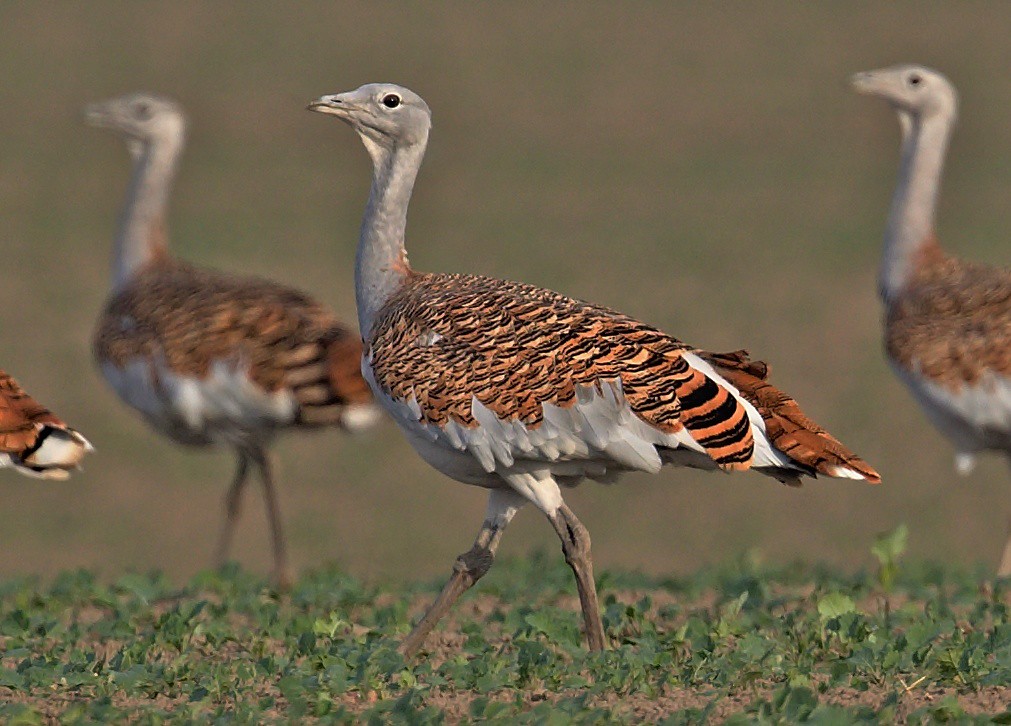 The great bustard is the largest European flying bird species. In Slovakia, it was rather common in the past, however, it is now one of our most endangered species - it occurs regularly only in a single locality at the borders of Slovakia, Austria, and Hungary.
The great bustard is the largest European flying bird species. In Slovakia, it was rather common in the past, however, it is now one of our most endangered species - it occurs regularly only in a single locality at the borders of Slovakia, Austria, and Hungary.
Its nesting is extremely rare, representing only a couple of pairs. This year, a nest was found here for the first time in 12 years. Just before autumn and winter the bustards gather up to flocks at the borders of the three countries. There may be up to 500 wintering here. Over the past years, great numbers have stayed in the territory of Slovakia. They need sufficient amount of food and quiet.
„Based on the monitoring, we assume that this year 2-5 females of the great bustard nested in the Sysľovské polia Special Protection Area (SPA). In one case, for the first time in 12 years, we managed to find a nest in May, which made us very happy. In cooperation with the user, the relevant authorities have determined such a farming regime so that any disturbance was omitted and the bustard could breed, “says Jozef Ridzoň from the Slovak Ornithological Society/BirdLife.
“Undoubtedly, the bustards have nested thanks to the fact that people are more respectful of the rules for the nature conservation in this area, such as the trespassing the places where it is important to keep quiet for nesting and wintering birds. In the case of bustard, this is one of the key factor for its survival. In 2020, due to the restrictions following the pandemic situation, there was such an extreme strain to the area and the turnout so high, that no female bustard nested here. As this is the only known nesting site, the bustard did not nest at all in Slovakia in 2020,” says Radovan Michalka from the State Nature Conservation of the Slovak Republic.
“Many people are surprised that bustards even occur near Bratislava, as there are mostly intensively cultivated fields. Scientific works claim that the bustards can get used to the movement of mechanical devices (tractors, combine harvesters and the like) and move away from them in a calm way, and the people in the cabs do not disturb them. By contrast, when it comes to pedestrian visitors, cyclists, or skaters, and suchlike, the bustards are disconcerted and they fly away.” informs Jozef Chavko from the Raptor Protection of Slovakia.
“The bustards are gathering into flocks these days, and in cooperation with the colleagues from Hungary and Austria we have been monitoring the wintering population in the tri-border area. It will be crucial to provide the bustards with quiet even in cold days, when they find less food and need more energy to survive. Flying due to disturbance could make them too exhausted. With the support of the European Union the LIFE Steppe on border project has been currently under way. Thanks to the project, more than 112 hectares of the intensively cultivated land in Sysľovské polia SPA will be changed to varied grasslands, which will subsequently improve the bustard’s foraging conditions,” says Ridzoň.
After 2010 no successful breeding of the great bustard was confirmed in Slovakia. It was not until 2021 when non-flying chicks were observed. The thing is that in 1956, there were still 1165 bustards living here. The aim of the LIFE Steppe on border project is to save the bustard from extinction, to prevent losing its last nesting population we have in Slovakia. The special significance is given to the activities focused on reconciling interests of nature conservation and local residents, such as defining of bike paths, creating of new elements for recreation and education, and improving of the signage in the territory,” concludes Chavko.






